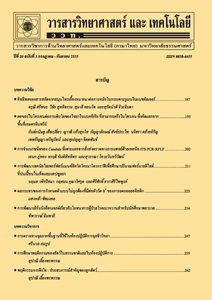ผลของสภาวะการเก็บรักษาต่อการเกิดรีโทรเกรเดชันและการเปลี่ยนแปลงสมบัติทางกายภาพและเคมีของผลิตภัณฑ์ขนมขบเคี้ยวจากข้าวและถั่วเหลืองโดยกระบวนการเอกซ์ทรูชัน
Main Article Content
บทคัดย่อ
บทคัดย่อ
ศึกษาผลของสภาวะการเก็บรักษาต่อการเกิดรีโทรเกรเดชันและสมบัติทางกายภาพ (สีและลักษณะเนื้อสัมผัส) และเคมี (ปริมาณแอมิโลส แอมิโลเพคติน และแป้งรีซิสแตนท์) ที่เปลี่ยนแปลงไปในผลิตภัณฑ์ขนมขบเคี้ยวจากข้าวและถั่วเหลือง โดยเริ่มต้นศึกษาผลของสภาวะการเก็บ 2 ปัจจัย ได้แก่ อุณหภูมิ (-18, 4, 28 และ 50 °C) และระยะเวลาในการเก็บรักษา (0-6 เดือน) พบว่าสภาวะการเก็บที่อุณหภูมิสูง (28 และ 50 °C) ส่งผลให้โมเลกุลของแป้งในผลิตภัณฑ์เกิดรีโทรเกรเดชันได้เร็วกว่าการเก็บที่อุณหภูมิต่ำ และระยะเวลานานขึ้นส่งผลให้ช่วงอุณหภูมิของการเกิดเอนโดเทอมรีโทรเกรเดชันมีแนวโน้มสูงขึ้นและยังพบการเกิดสารประกอบเชิงซ้องของแอมิโลสและลิปิดด้วย และเมื่อศึกษาสมบัติของผลิตภัณฑ์ที่เปลี่ยนแปลงไป พบว่าปัจจัยหลัก คือ ระยะเวลาในการเก็บรักษาและอิทธิพลร่วมระหว่างระยะเวลาและอุณหภูมิ (p < 0.05) ในขณะที่อุณหภูมิในการเก็บรักษาส่งผลต่อคุณภาพของผลิตภัณฑ์ในบางสมบัติ โดยระยะเวลามีผลต่อการเปลี่ยนแปลงค่าสี L* และ b* ค่าความกรอบ ปริมาณแอมิโลส และแอมิโลเพคติน และปริมาณแป้งรีซิสแตนท์มากกว่าอุณหภูมิ ส่วนค่าสี a* และค่าความแข็งกระด้างขึ้นอยู่กับอุณหภูมิมากกว่าระยะเวลา ทั้งนี้อุณหภูมิในการเก็บไม่มีผลต่อค่าความกรอบและปริมาณแป้งรีซิสแตนท์
คำสำคัญ : สภาวะการเก็บรักษา; การเกิดรีโทรเกรเดชัน; สมบัติทางกายภาพและเคมี; สมบัติเชิงสุขภาพ; ผลิตภัณฑ์ขนมขบเคี้ยวจากกระบวนการเอกซ์ทรูชัน
Article Details
References
[2] Gudmundsson, M., 1994, Retrogradation of starch and the role of its components, Thermoclimica Acta 246: 329-341.
[3] Eerlingen, R.C., Crombez, M. and Delcour, J.A., 1993, Enzyme resistance starch: I. Quantitation and qualitative influence of incubation time and temperature of autoclaved starch on resistant starch formation, Cereal Chem. 70: 339-344.
[4] ศันสนีย์ อุดมระติ, 2548, การเกิดเจลาทิเนเซชันและรีโทรเกรเดชันของสตาร์ชข้าว 4 พันธุ์, วิทยานิพนธ์ปริญญาโท, มหาวิทยาลัยเกษตร ศาสตร์, กรุงเทพฯ, 162 น.
[5] Eliasson, A.C. and Gudmundsson, M., 1996, Starch: Physicochemical and Function Aspects, pp.431-503. In Eliasson, A.C. (Ed.), Carbohydrate in Food. Marcel Dekker, Inc., New York.
[6] Chung, J.H., Jeong, H.Y. and Lim, S.T., 2003, Effect of acid hydrolysis and defatting on crystallinity and pasting properties of freeze-thawed high amylase corn starch, Carbohydr. Polym. 54: 449-455.
[7] Biliaderis, C.G., Tonogai, J.R. Perez, C.M. and Juliano, B.O., 1993, Thermophysical properties of milled rice starch as influenced by variety and parboiling method, Cereal Chem. 70: 512-516.
[8] Ong, M.H. and Blanshard J.M.V., 1995, Texture determinants of cooked, parboiled rice: II. Physicochemical properties and leaching behaviour of rice, J. Cereal Sci. 21: 261-269.
[9] Lii, Y.C., Lai, V.M.F. and Shen, M.C., 2004, Changes in retrogradation properties of rice starch with amylase content and molecular properties, Cereal Chem. 81: 392-398.
[10] Vamndeputte, E,G., Vermeylen, R.V., Geeroms, J. and Delcour, J.A., 2003, Rice starch: III. Structure aspects provide insight in amylopectin retrogradation property and gel texture, J. Cereal Sci. 38: 61-68.
[11] Jeremiah, L.E. and Gibson, L.L., 2001, The influence of storage temperature and storage time on color stability, retail properties and case life of retail ready beef, Food Res. Int. 34: 815-826.
[12] Sowbhagya, H.B., Smitha, S., Sampathu, S.R., Krishnamurthy, N. and Bhattacharya, S., 2005, Stability of water-soluble turmeric colorant in an extruded food product during storage, J. Food Eng. 67: 367-371.
[13] Yu, S., Ma, Y. and Sun, D.W., 2009, Impact of amylase content on starch retrogradation and texture of cooked milled rice during storage, J. Cereal Sci. 50: 139-144.
[14] Larsen, H., Lea, P. and Rodbotten, M., 2005, Sensory changes in extruded oat stored under different packaging, light and temperature conditions, Food Qual. Prefer. 16: 573-584.
[15] Hirte, A., Hamer, R.J., Meinders. And Primo-Martin, C., 2010, Permeability of crust is key to crispness retention, J. Cereal Sci. 52: 129-135.
[16] Launay, B. and Lisch, J.M., 1983, Twin screw extrusion cooking of starched: Behavior of starch pastes, expansion and mechanical properties of extrudates, J. Food Eng. 2: 259-280.
[17] Mercier, C. and Feillet, P., 1975, Modification of carbohydrate components by extrusion-cooking of cereal products, Cereal Chem. 52: 283-297.
[18] Copeland, L., Blazek, J., Salman, H. andTang, M.C., 2009, Form and functionality of starch, Food Hydrocoll. 23: 1527-1534.
[19] Kumari, M., Urooj, A. and Prasad, N.N., 2007, Effect of storage on resistant starch and amylase content of cereal-pulse based ready-to-eat commercial products, Food Chem. 102: 1425-1430.
[20] Mangala, S.L., Udayasankar, K. and Tharanathan, R.N., 1999, Resistant starch from processed cereals: the influence of amylopectin and non-carbohydrate constituents in its formation, Food Chem. 64: 391-396.
[21] Namratha, J., Asna, U. and Prasad, N.N., 2002, Effect of storage on resistant starch content of processed ready-to-eat foods, Food Chem. 79: 395-400.
[22] Niba, L.L., 2003, Effect of storage period and temperature on resistant starch and -glucan content in cornbread, Food Chem. 83: 493-498.
[23] Kingcam, R., Devahastin, S. and Chiewchan, N., 2008, Effect of starch retrogradation on texture of potato chips produced by low-pressure superheated steam drying, J. Food Eng. 89: 72-79.
[24] Yu, S., Ma, Y. and Sun, D.W., 2009, Impact of amylase content on starch retro-gradation and texture of cooked milled rice during storage, J. Cereal Sci. 50: 139-144.
[25] Iturriaga, L.B., Mishima, B.L. and Añon, M.C., 2010, A study of the retrogradation process in five argentine rice starches, LWT-Food Sci. Technol. 43: 670-674.
[26] Park, E.Y., Baik, B.K. and Lim, S.T., 2009, Influences of temperature-cycled storage on retrogradation and in vitro digestibility of waxy maize starch gel, J. Cereal Sci. 50: 43-48.

